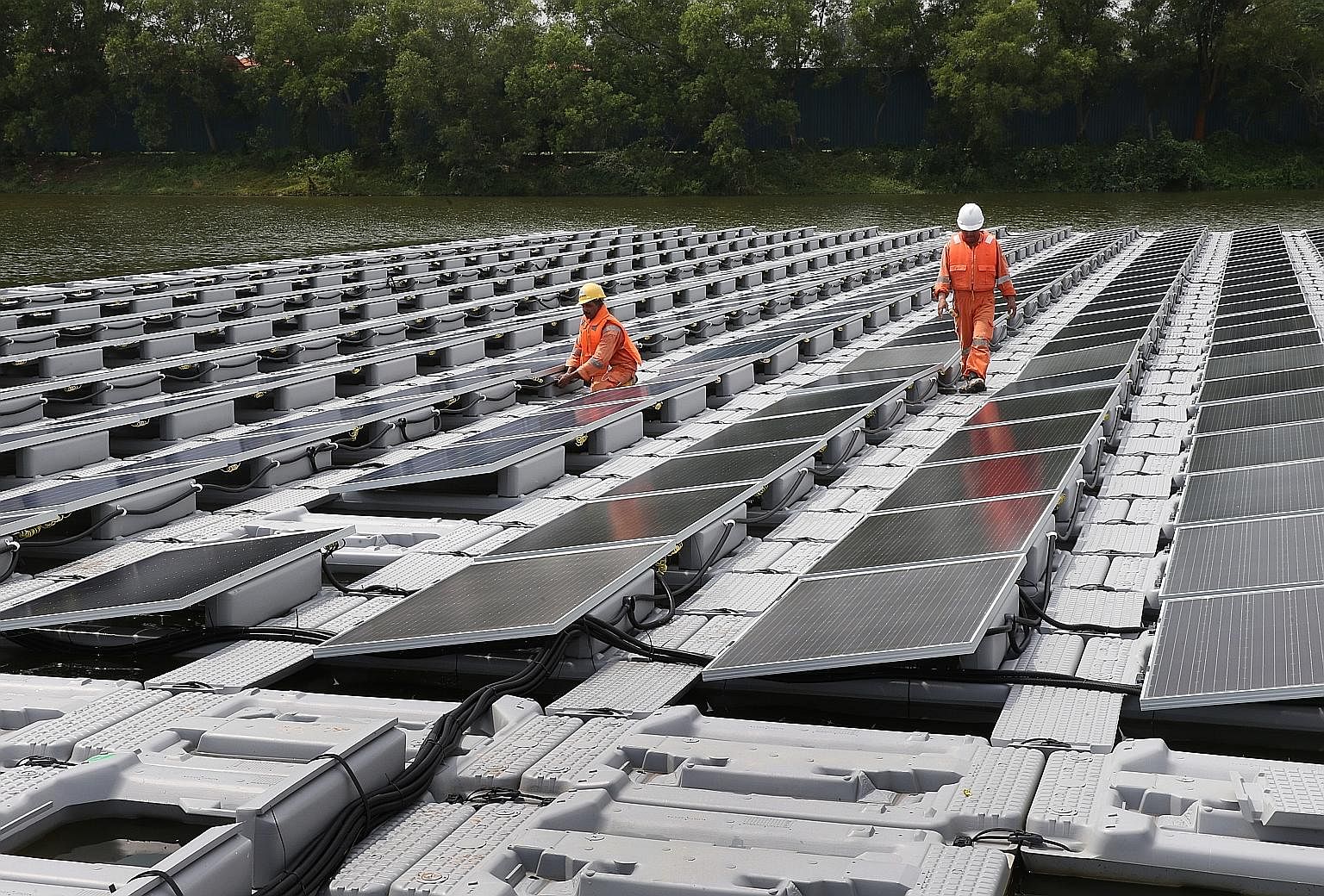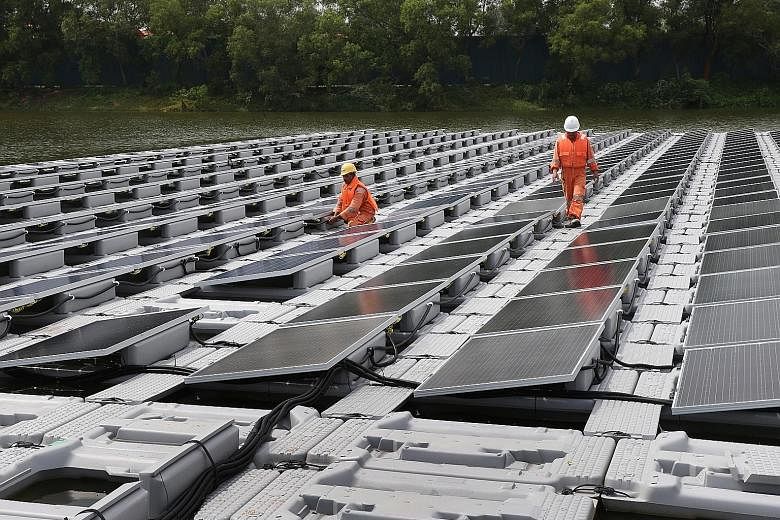At the grand entrance of the American Museum of Natural History in New York City is a relic from the past that speaks of the world's future - and it is not the skeleton of a dinosaur.
Quite the opposite. Now that a global pact to steer the world away from catastrophic climate change has been inked, a quote on a wall aptly sums up the world's ambition to treat "natural resources as assets which it must turn over to the next generation increased, and not impaired, in value". Former United States president Theodore Roosevelt said this nearly a century ago. Today, this sentiment is known by a more familiar catchphrase: sustainable development.
It is internationally defined as development that meets the needs of the present without compromising the ability of future generations to meet their own.
Singapore has jumped on the bandwagon. Today, the Republic boasts green cars, green buildings and research into green energy. But what does being a responsible steward of natural assets have to do with Singapore - a country with no natural resources?
CLIMATE CHANGE
Singapore has been consuming natural resources from beyond its borders - resources under threat by climate change.
Up to 60 per cent of Singapore's water is from Malaysia, and more than 90 per cent of its food from around the world. But the extreme weather patterns symptomatic of climate change - such as floods and dry spells - are wreaking havoc on these supplies.

Last October, water levels at Johor's Linggiu Reservoir reached a historic low of 20 per cent, after a prolonged dry spell in 2014 led to steadily declining levels there. The Linggiu Dam is Singapore's main source of water in Malaysia.
-
About The Big Quiz
-

Each Monday, the paper's journalists will address burning questions in the Opinion section, offering unique Singaporean perspectives on complex issues.These primers form part of the outreach of The Straits Times- Ministry of Education National Current Affairs Quiz, or The Big Quiz, which aims to promote an understanding of local and global issues among pre-university students.
Underpinning this year's quiz is a focus on disruption, a timely issue as various sectors and industries adapt to this global change.
The theme was featured in six campus talks helmed by editors and correspondents.
Six quiz rounds were also held for students to demonstrate their current affairs knowledge.
The six winning schools were Anglo-Chinese Junior College, Meridian Junior College, Nanyang Junior College, Dunman High School, Hwa Chong Institution and Pioneer Junior College.
The nationwide event is jointly organised by The Straits Times and the Ministry of Education, with the Singapore Press Holdings Foundation as its presenting sponsor.
•For more information or to view additional resources, go to https://www.straitstimes.com/tags/the-big-quiz
•For more information related to the environment and sustainability, go to: http://str.sg/46jT
•The primer series will take a break and resume on July 10.
And a study by the Nanyang Technological University's S. Rajaratnam School of International Studies had noted that by 2030, rice production in Thailand's rice bowl in the north-east could be reduced by up to 17.8 per cent due to flooding and storm surges. Fish catch potential in the waters of South-east Asia could also shrink by up to 60 per cent, as fish migrate away from the Equator to escape warmer oceans and increasingly acidic waters.
Though the Republic may generate only about 0.11 per cent of global emissions, it still has to do its part "as a responsible and vulnerable member of the global community", in the words of Minister for Foreign Affairs Vivian Balakrishnan.
Singapore has been working to combat climate change by reducing its greenhouse gas emissions and adapting to the effects of climate change that can already be felt. This has been done by following the 3Rs: Reduce, Reuse and Re-adapt.
REDUCE
The first step to reducing emissions is to get people to use less resources. Singapore is doing this with its promotion of energy efficiency at home and in the workplace. This boils down to the use of less resources to achieve the same result, such as lighting a room with an energy-saving LED bulb instead of a fluorescent one.
Last month, changes were made to the Energy Conservation Act to force large energy users to do more for energy efficiency - including ensuring that common industrial equipment and systems meet minimum energy performance standards. Reducing the use of resources could also extend their lifespan - crucial, if climate change is causing their depletion. However, Singapore's move to do this did not come without controversy.
In February, the Government announced a 30 per cent water price hike that will be implemented over two phases to reflect costlier investments in weather-proof technology such as desalination and Newater, and to encourage its conservation.
There was a backlash with people protesting against the price hike, although experts welcomed it as a good way of controlling demand.
On the waste front, using less is also important for Singapore, considering it has but one landfill on Semakau Island that is filling up at an alarming rate. Its deadline is 2035 - a decade sooner than the original 2045 projection.
Singapore is looking to enact a law in the next three to five years to reduce packaging waste, which makes up a third of all household waste, Minister for the Environment and Water Resources Masagos Zulkifli said last July.
REUSE
Reusing resources also helps extend the lifespan of what is available. Singapore has a plan to reuse water endlessly, and national water agency PUB is already achieving this with its Newater technology that allows used water to be purified and used again.
Reusing nature's provisions to meet urban needs can also help to reduce greenhouse gas emissions. Unlike countries which have large tracts of land for the installation of solar panels, Singapore is land-scarce. But plenty of research is being done on this front to see how sunny Singapore can overcome its space constraints. This includes the setting up of the world's largest floating solar-cell test bed.
Ten different systems are being tested in the $11 million project at Tengah Reservoir, as scientists evaluate the performance and cost-effectiveness of each one.
Local solar energy firm REC Solar has also designed a new panel which is able to work even if part of it is shaded, something conventional panels cannot do. Its makers believe such a panel could be a possible solution to the lack of space in Singapore for conventional solar panels.
The hope is that Singapore could by 2050 meet 30 per cent of its energy needs with solar power. Right now, 95 per cent of Singapore's energy comes from natural gas . This may be the cleanest form of fossil fuel around - but it is still a fossil fuel.
RE-ADAPT
To safeguard its people and economy, Singapore has to adapt to changes in the climate. According to the projections from Singapore's Second National Climate Change Study, mean sea level is estimated to rise by up to about 1m by 2100.
The Ministry for the Environment and Water Resources has said that the sea-level rise is expected to be a gradual process that will take place over several decades. But Singapore has already taken steps to adapt to the changing environment.
In 2011, for example, the authorities raised the minimum reclamation level to at least 4m above mean sea level, which is an increase of 1m. Selected roads, such as Changi Coast Road and Nicoll Drive, have also been raised to reduce the impact of flooding. To mitigate coastal erosion, seawalls and rock slopes near the coasts have also been installed.
But re-adaptation has to go beyond the physical environment. Mindsets, too, have to be changed.
Estimates have shown that even if countries keep to their pledges for emission cuts under the Paris Agreement,total emissions in 2030 will still exceed what is needed to keep global warming to an internationally agreed target of 2 deg C this century.
So while Singapore has enacted laws to help it tackle climate change, every individual needs to feel that he has the power to make a difference. This applies even with the simplest of actions, such as turning off lights that are not in use. Without this conviction, the world may well go the way of the dinosaurs.

Have a burning question related to this week's Primer topic?
E-mail us at askST@sph.com.sg
For more information, go to www.straitstimes.com/askST


